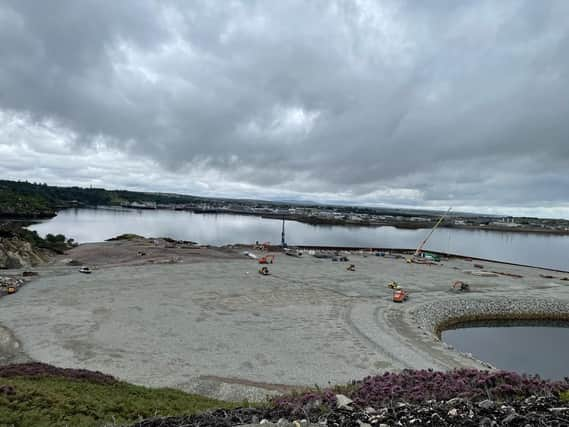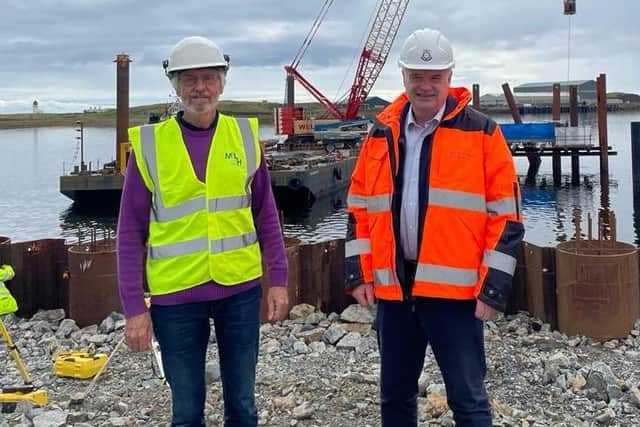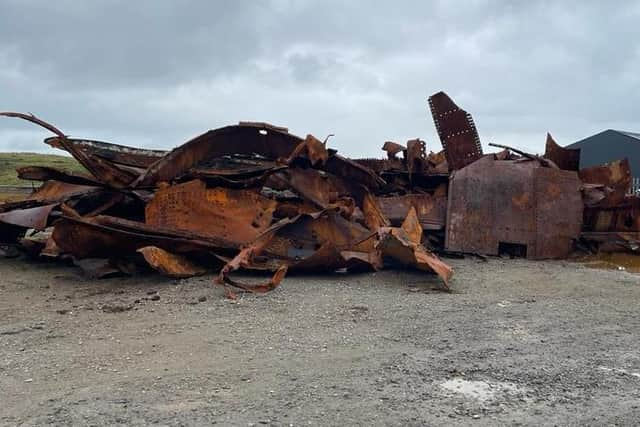A terminal that is key to big challenges


Already, the demand from cruise operators is booming with 100 vessels scheduled to discover Stornoway next year, many of them attracted by the new facilities. With the first due to arrive at the beginning of April, Alex Macleod says: “We’ve got to be ready”. He reckons next year will bring around 80,000 cruise visitors to Lewis “and it could be more”.
That raises its own questions about how prepared the island is to respond. However, for Stornoway Port Authority the immediate objective is to get the job done on time and within its £59 million budget. On both counts, the outlook is positive. By the end of this year, the main contractors should have completed their work.
Advertisement
Advertisement
As chief executive of Stornoway Port, Alex has driven the vision from its inception but is already looking further ahead. He says: “It is the start of a scale of investment that we haven’t seen here before. The challenge of managing all the different industries which are going to use the facilities hasn’t even begun.


“It is a big undertaking and there are risks involved but we assessed the risks and are very comfortable”. Indeed, much that has happened since the decision to proceed was taken by the Authority, with backing from Comhairle nan Eilean Siar and HIE as well as its own resources, has reinforced the case and enhanced the opportunities.
At that time, there was still no confirmation of an interconnector across the Minch and even less word of offshore wind developments. The Arnish fabrication yard, which has since become part of the revived Harland & Wolff Group, was lying dormant. All that has changed dramatically and the port facility will be critical to each aspect.
The cruise ship influx will be the first evidence of the difference that the deep water investment will make to the island economy. In the longer term, the options it opens up for the Arnish yard; the road which has been built to accommodate the largest blades for wind turbines; and the second quay to handle freight traffic will each become equally significant.
Advertisement
Advertisement
In other words, the critical functions that the terminal will serve have already expanded with the potential for much more to come. Alex Macleod says: “The reality is that because of the scale of these other developments, we are going to need more investment in the port as well. We will always look at creating more quayside options”.


The scale of the current development has to be seen to be appreciated but numbers help to tell the story. A million tonnes of sand and gravel have been dredged from the seabed and a million tonnes of rock have been blasted from the surrounding terrain. All of that material has gone into land reclamation to create the quays at which vessels will berth with 10 hectares available for other port activities. Five thousand tonnes of steel have gone into the pilings and anchor walls.
As far as sticking to budget is concerned, once it had been fixed at £59 million, the biggest challenge was created by the Russian invasion of Ukraine. Both Ukraine and Belarus were major steel exporters and once this was unavailable in the west, the price shot up. While the contractors were able to secure supplies from Germany, the increased costs necessitated other modifications, but nothing too serious.
“It shows how global supply chains have been affected by Ukraine in surprising places and surprising ways”, says Alex Macleod. All such problems have been overcome helped by good relationships with the main contractors, McLaughlin & Harvey, and other key players on the site.
Advertisement
Advertisement
A significant proportion of the work has stayed local. Breedon, as contractors for the rock blasting and ground works which accounts for about a quarter of the overall cost, have used several local companies as sub-contractors and suppliers. The Authority’s marine engineering consultants, Wallace Stone, have a local base and the man in charge on site, John Porteous, lives in Bernera.
John, who has worked for 40 years with Wallace Stone, says: “Logistically, it has been a big undertaking but technically it is relatively straightforward – dredging of the seabed, rock blasting and steel piling. We just finished the Tarbert ferry terminal works which had a third of the value but was a much more complex engineering project than this one”.
He adds that the carbon footprint created by the reclamation is “exceptionally low”. The pinkish material which forms most of the reclaimed land was dredged from the seabed by a Dutch specialist contractor. John says: “It’s what they do in Holland all the time with polders. They brought in a very large ship in size and weight, which works on projects like this all over the world.
“Basically, it acts like a big hoover, gathering up the sand and gravel. It was here for eight weeks with two crews, working round the clock, moving at two knots so that it looked like it was hardly moving at all, until the whole lot was transferred into reclamation. Up on the bridge, it was an oasis of calm. It was an amazing operation and then the ship headed off to Africa”.
Advertisement
Advertisement
Week by week, the milestones are being ticked off. Another will be reached within the next few days when the complex task of raising the coal hulk, “Portugal”, from the harbour entrance will be completed. This was one of two historic shipwrecks which were known to block the channel to large vessels before the project began.
The first, the SS Alabama, was a cargo ship which sank in 1904 after seeking a safe haven while on passage from Copenhagen to Baltimore. There she has lain ever since, protruding above sea level at low tide. Now her superstructure has been removed to provide the eight metre draft required for the largest ships.
That was relatively straightforward but the SS Portugal was more challenging. She was being used to store coal for Stornoway when struck by another vessel in 1951. There were subsequent efforts to blow up the wreck which dispersed twisted fragments around the seabed. Everything had to be removed and the piles of rusted steel now lying at Arnish, traces of coal still showing, are testament to the outcome of that operation.
Round the corner from the main site, towards the Castle Grounds, lies the second quay that the project will create. Alex Macleod explains: “The logic for the linkspan berth was that we always anticipated a dedicated freight ferry will be needed on the Ullapool route. I’m pretty sure there will be a freight ferry here within the next few years”.
Advertisement
Advertisement
The arguments in favour of that were already strong. A dedicated freight ferry would allow the MV Loch Seaforth to operate three crossings a day, to meet demand from cars and passengers while a dedicated vessel would provide a more reliable service for freight. It would also take most of it out of the town, with plenty space for marshalling facilities.
All these merits have been multiplied by the prospect of an interconnector and windfarms which will massively increase the amount of hardware coming into the island. Realistically, the vast majority of this will have to come by sea and the demand for enhanced freight facilities would have become irresistible even if they were not already planned for.
Alex also sees great potential benefits for the Harland & Wolff Arnish yard. “At the moment, they are very restricted in what they can do but access to deep water will be transformational”. Again, the timing of the port development could not be better in the light of events that have unfolded.
A road is being built to connect the main terminal site to Arnish while at the other end of the development a footpath will create access between the newly-reclaimed area and the Castle grounds network of paths, to the benefit of locals and visitors alike. As the jigsaw comes together, the diversity of potential benefits also becomes more apparent.
Advertisement
Advertisement
The big problem which is well outside the control of Stornoway Port Authority is that other facilities on the island are not advancing at the same pace and there is clear potential for this lack of symmetry to create problems. The question of roads is an obvious area of contrast.
Alex Macleod says the 300 metre stretch that has been blasted out of rock to link the current Arnish road with the reclaimed quays is the biggest road project in the islands for 15 years. Meanwhile, as Comhairle nan Eilean Siar chief executive, Malcolm Burr, told the Gazette last week, they have no money for roads in the capital budget and barely enough for “care and maintenance” of what exists.
The lack of infrastructure in the islands is already creating conflicts between tourism and other interests. Exactly how that will be reconciled with the number of cruise ship visitors being doubled or trebled remains to be seen but somebody certainly needs to be thinking about it before they arrive.
Alex Macleod offers some reassurance on this point. “We’re used to cruise ships with 1500 to 2000 passengers coming ashore – in fact there was one last Saturday. So there won’t be more people arriving on any given day. There will just be more days with these numbers to deal with”. Nonetheless, he agrees that there needs to be a co-ordinated approach to how the influx is turned into economic benefit, spread as widely as possible.
Advertisement
Advertisement
If these benefits are going to extend throughout the islands rather than remain concentrated in Stornoway and a couple of tourism hot-spots, the long-delayed attractions of the kind cruise ship visitors are looking for need to be delivered. That too is outside the control of the impoverished local authority.
At the same time, the energy-related projects on the horizon run into billions of pounds of investment. The delivery of them is going to make additional demands on an infrastructure which is already creaking at the seams. As Alex Macleod says: “It is the start of a scale of investment we haven’t seen here before”.
The new port development is a crucial lynchpin which will certainly bring great opportunities but also no shortage of challenges which need to be recognised and planned for.